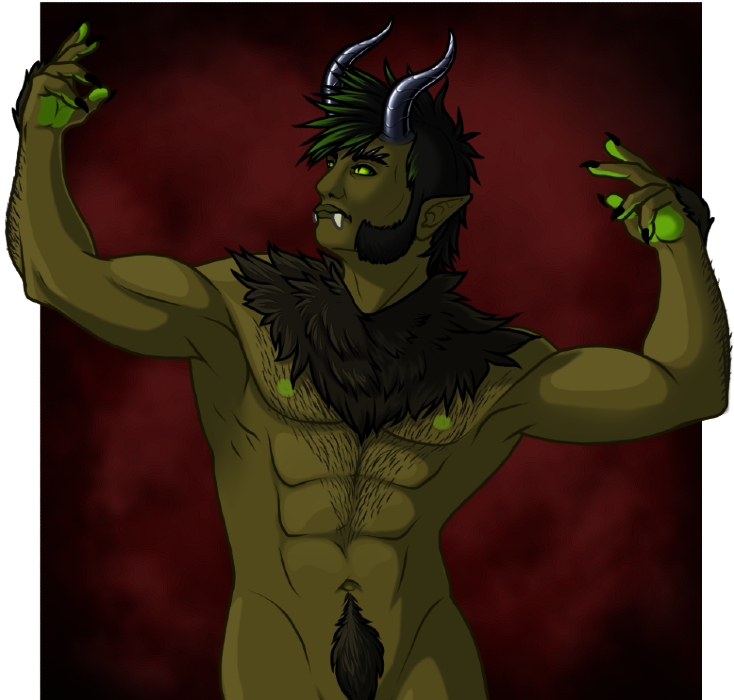Clans have complex hierarchies because of the relationship with orks and enslavement. One may be able to ‘earn’ their way out of enslavement from the orks or their own tribe by proving themselves worthy in some manner, usually through some great feat in battle, hunting, or other other valorous actions. Intelligence, talent, or affinity for magic alone do not help one gain freedom unless they prove themselves worthy.
GOTH (GOTHU) - “Master (Masters)”
Despite Grat being free wargkesh, they are still considered lower-class citizens than orks. Thus, all orks are called Goth regardless of status. The title may also be given to demons as well, depending on the demon’s power.
GRAT (GRATU) - “Chief (Chiefs)”
Usually attained by challenging and defeating the previous Grat in battle, but the title may be inherited as well. One may only challenge a Grat if they are no longer a snaga to the orks or wargkesh clan, and if the Grat is at least 30. Gratu may take as many mates from any rank of the clan as they wish, so long as those are not snagaz.
Gratu who survive being challenged but admitted defeat are considered higher than the average clan member, but are not afforded any more say in clan matters until they become a Kû - an elder.
The greatest Gratu have all been fertile intersex, thanks to their ability to breed with all other fertile genders, in addition to their greater muscle and fat mass than males. Thusly, intersex wargkesh in general are considered more valuable to the clan.
Gratu choose their own tattoos and markings, but avoid those used by other ranks.
TAB-NAAKH/TOB-NAAKH (TAB-NAAKHU/TOB-NAAKHU) - “His or Their Hand/Her Hand (His or Their Hands/Her Hands)”
The mate or mates of the Grat are considered somewhat beneath them, but still hold a large amount of power and are above all others in the clan once the Grat has chosen them. If they fall out of favor with the Grat, former Tab-naakh and Tob-naakh are still considered higher than the average clan-member, but no longer above the Dushûrz, Slaium-thrakal, or Nalt-kûz.
DUSHÛRZ - “Magical”
Dushûrz are the shamans/mystics, medicine-people, demon/spirit-talkers, and council of the Grat. They are free people chosen specifically for their magical talent and wisdom. One must be at least 50 to become a Dushûrz. They usually paint or tattoo themselves with crescents and circles to invoke the moon and stars of the over-world.
SLAIUM-THRAKAL (SLAIUM-THRAKALU) - “Life-Bringer (Life-Bringers)”
The “midwives'' of the wargkesh can be any gender, and are generally chosen from among the elders who show instinctive drives towards caring for others. They also care for those too old or infirm to care for themselves and, ironically, also give those that wish it a merciful end. They usually paint or tattoo themselves with semi-circles to invoke the power of the rising and setting of the sun
.
NALT-KÛ (NALT-KÛZ) - “High-Elder (High-Elders)”
Any unenslaved wargkesh that have reached the age of 100 are considered High-Elders, and, with the Dushûrz, aid the Grat in decision-making. They usually paint or tattoo themselves with images of skulls (without the lower jaw) to invoke the power of the demons and spirits, in addition to the markings they received as Kûz.
KÛ (KÛZ) - “Old/Elder (Old Ones/Elders)”
The Elders of a clan are considered not only wise, but powerful, as they have survived the rigors of orkish and wargkesh society to a venerable age. All wargkesh are considered Kû at age 90. They are respected and given preferential choice of kills after the ranks above them have chosen. They usually paint or tattoo themselves with three slashes - like claw-marks - to remind others of the beasts, enemies, and trials they survived to reach a venerable age.
SHA-M DÛRZ (SHA-M DÛRZU) - “Free Person (Free People)”
Sha-mâdûrzu are not enslaved by either the orks or their own clans because they were either born to another free wargkesh, they earned their way to freedom, or were set free by their orkish masters, but not exiled. Sha-mâdûrzu are the lowest rank that are permitted to choose their own mates, but only within the clan. A free wargkesh may mark themselves as free by adorning themselves with paw-prints, dots, swirls, and other, more abstract symbols not taken by higher ranks.
SNAGA (SNAGAZ) - “Slave (Slaves)”
These are slaves of the orkish people and, while able to join and contribute to clans, cannot decide on whom to mate with and must cater to the whims of the orks first before those of the clan.
WARGKESH SNAGA (WARGKESH SNAGAZ) - “Wargkesh Slave (Wargkesh Slaves)”
Slave of the wargkesh clan their breed belongs to. The lowest of the low in wargkesh society, they are treated as livestock even by other wargkesh. They have no rights of their own, and their magical abilities (shifting, fire) are only developed if their masters wish them to.
BAAK (BAAKU) - “The Shame (The Shames)”
The exiled wargkesh are no longer considered part of wargkesh society, and are even lower than wargkesh-snaga. Whether because they have broken a clan law, or simply been cut loose by their masters because they were not considered worthy, Baaku occasionally band together to form their own mock-clans in order to survive. Others become hermits, or attempt to barter themselves (back into) slavery.


 Sex and gender are considered separate in wargkesh society. The three sexes are male, female, and intersex. However, trans/non-binary genders are recognized as normal. See The Gender Wiki for more terms.
Sex and gender are considered separate in wargkesh society. The three sexes are male, female, and intersex. However, trans/non-binary genders are recognized as normal. See The Gender Wiki for more terms.